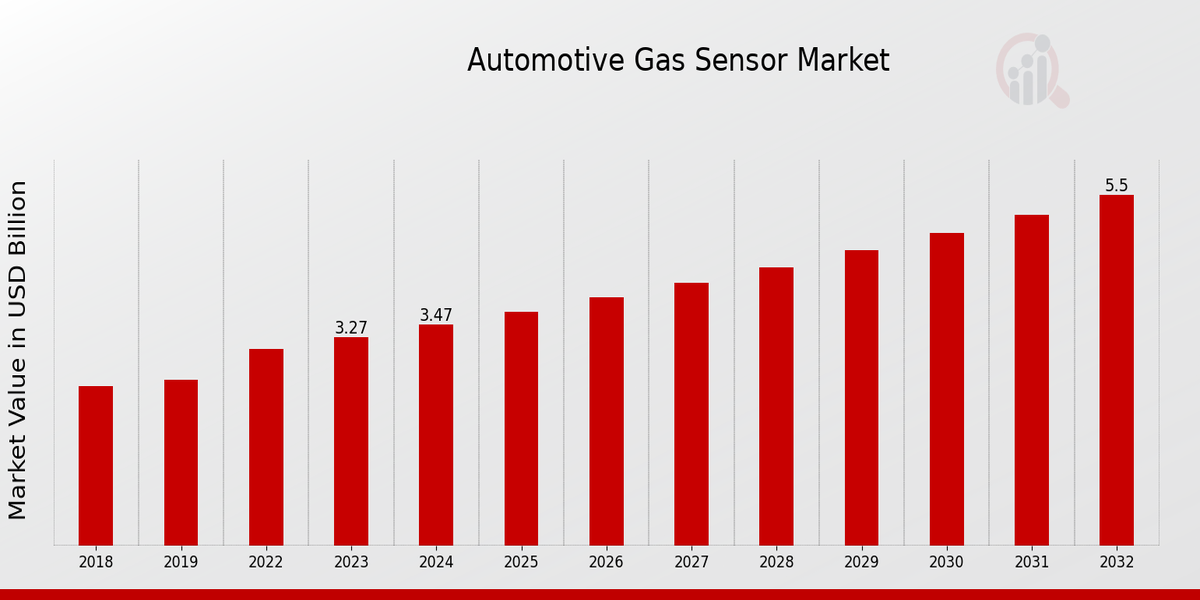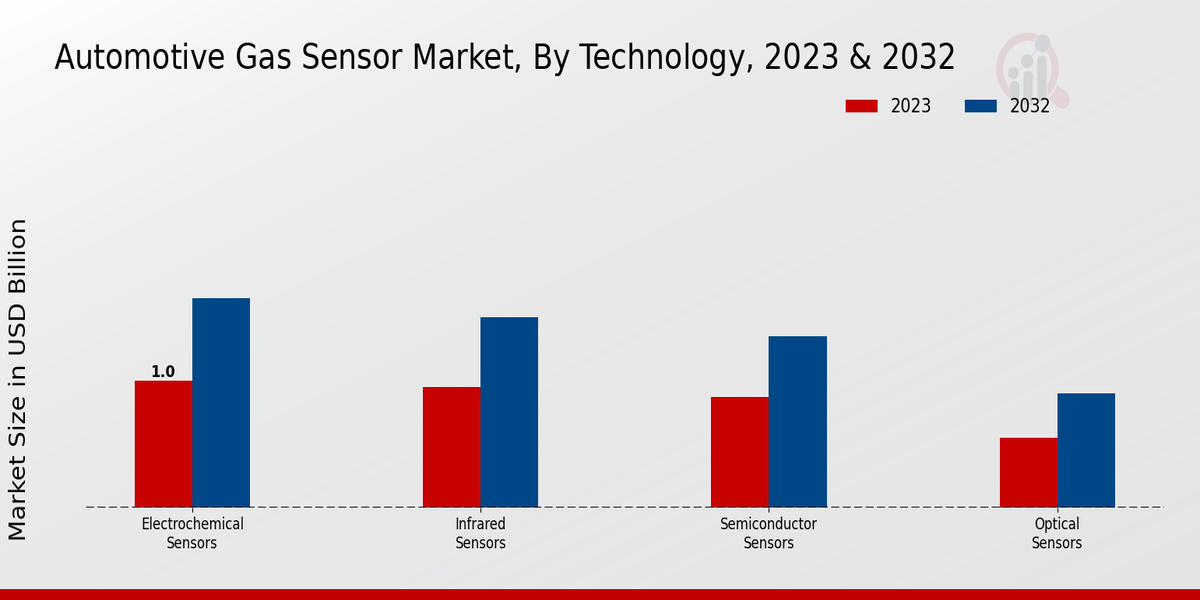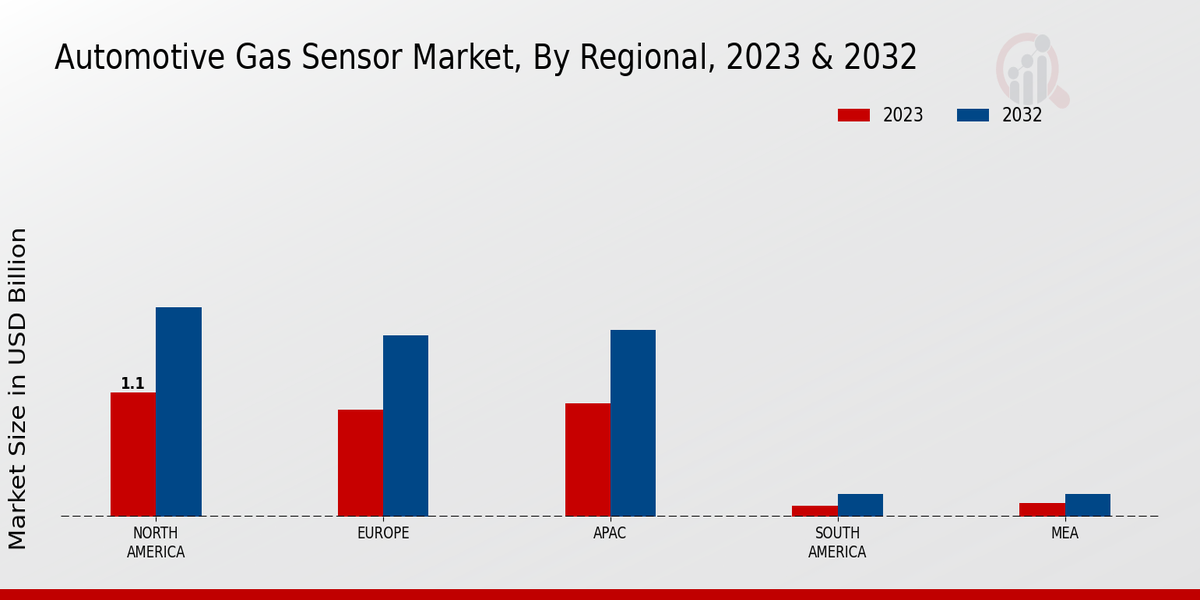Automotive Gas Sensor Market Overview:
As per MRFR analysis, the Automotive Gas Sensor Market Size was estimated at 3.67 (USD Billion) in 2024. The Automotive Gas Sensor Market Industry is expected to grow from 3.89 (USD Billion) in 2025 to 6.54 (USD Billion) till 2034, at a CAGR (growth rate) is expected to be around 5.93% during the forecast period (2025 - 2034).
Key Automotive Gas Sensor Market Trends Highlighted
The Global Automotive Gas Sensor Market is witnessing significant growth driven by the increasing demand for advanced emission control technologies and stricter environmental regulations. Manufacturers are focusing on developing sensors that can detect various gases, ensuring compliance with regulatory standards while enhancing vehicle performance.
The surge in electric and hybrid vehicle production is also pushing the need for precise gas-sensing solutions that monitor battery performance and overall vehicle efficiency. This shift towards cleaner technologies is a primary driver of market expansion.
There are numerous opportunities to be explored within this market, particularly as advancements in sensor technology continue to evolve.
The integration of artificial intelligence and machine learning in gas sensors can lead to improved accuracy and faster response times. Additionally, the rise of smart vehicles and connected car technologies provides a platform for innovative applications of automotive gas sensors, particularly in monitoring air quality and optimizing fuel consumption.
As consumers become more environmentally conscious, manufacturers can capitalize on the demand for eco-friendly solutions by investing in research and development of next-generation gas sensors.
Recent trends indicate a growing emphasis on the Internet of Things (IoT) and connected vehicle ecosystems, where gas sensors play a crucial role in real-time data transmission and analysis. The development of miniaturized and highly sensitive sensors is also on the rise, enabling more efficient monitoring systems that enhance the overall functionality of vehicles.
Moreover, the increasing emphasis on driver and passenger safety promotes the integration of gas sensors to detect hazardous gases, ensuring a safer driving environment. Collectively, these factors are contributing to a dynamic and evolving landscape for the automotive gas sensor market.

Source: Primary Research, Secondary Research, Market Research Future Database and Analyst Review
Automotive Gas Sensor Market Drivers
Increasing Environmental Regulations
The Global Automotive Gas Sensor Market is experiencing considerable growth driven by increasingly stringent environmental regulations implemented by governments worldwide. These regulations are aimed at reducing vehicle emissions and promoting cleaner air quality, which directly impacts the automotive sector.
As a result, automobile manufacturers are compelled to integrate advanced gas sensor technologies into their vehicles to monitor and control emissions of harmful gases such as carbon monoxide, nitrogen oxides, and hydrocarbons.
With the growing concerns over climate change and environmental degradation, the regulatory landscape is likely to become even more rigid, further stimulating the demand for automotive gas sensors. The integration of these sensors allows automakers to comply with regulatory standards while also enhancing the overall efficiency and performance of vehicles.
Additionally, these measures often come with incentives for manufacturers who adopt eco-friendly technologies, thus propelling further investments into gas sensor advancements.
By continuous monitoring of emissions and ensuring compliance, the automotive industry can contribute to sustainable development goals, enhancing its reputation in the market. This driver is potent not only due to its regulatory implications but also because it reflects a broader societal move toward sustainability, which consumers are increasingly valuing.
Therefore, stakeholders in the Global Automotive Gas Sensor Market must keep abreast of evolving regulations and invest in innovative sensing technologies to maintain a competitive edge in the market.
Rising Demand for Electric and Hybrid Vehicles
The shift toward electric and hybrid vehicles is a significant driver for the Global Automotive Gas Sensor Market. As the automotive landscape evolves, there is heightened interest in vehicles that produce lower emissions and depend on alternative energy sources.
This change not only caters to environmental concerns but also meets consumer preferences for fuel efficiency and cost savings. In response, automotive manufacturers are investing heavily in developing electric and hybrid models that require sophisticated gas sensors for monitoring battery performance, emissions, and operational efficiency.
The integration of these sensors into hybrid and electric vehicles enhances their overall performance and extends their market appeal among environmentally conscious consumers.
Technological Advancements in Sensor Technologies
Technological advancements are rapidly transforming the Global Automotive Gas Sensor Market, marking this as a key driver for growth. Innovations in sensor technologies, such as miniaturization, increased sensitivity, and improved accuracy, have expanded the capabilities of automotive gas sensors.
These developments enable real-time monitoring of emissions, significantly enhancing vehicle performance and compliance with environmental regulations. Manufacturers are now able to produce more reliable and cost-effective sensors, which further fuels industry growth.
As research and development in sensor technology continue to evolve, we can expect more advanced and efficient solutions to emerge, making them an integral part of modern automotive engineering.
Automotive Gas Sensor Market Segment Insights:
Automotive Gas Sensor Market Technology Insights
Specifically, the technology segment comprises Electrochemical Sensors, Infrared Sensors, Semiconductor Sensors, and Optical Sensors, each contributing uniquely to the market dynamics.
Electrochemical Sensors led the market, holding the majority with a valuation of 1.0 USD billion in 2023 and projected to rise to 1.65 USD billion by 2032. Their significance lies in their ability to detect carbon monoxide and other critical gases, making them essential for vehicle safety and emission control systems.
Infrared Sensors, closely following, were valued at 0.95 USD billion in 2023, expected to grow to 1.5 USD billion in 2032. They are crucial for non-dispersive infrared (NDIR) detection, providing accurate measurements of exhaust gases, which is vital for regulatory compliance and environmental impact reduction.
Semiconductor Sensors, valued at 0.87 USD billion in 2023 and projected to reach 1.35 USD billion in 2032, offer significant advantages in size and power consumption, making them ideal for compact vehicle designs where space is a limitation.
Lastly, Optical Sensors, though the smallest segment at 0.55 USD billion in 2023 with a projected increase to 0.9 USD billion by 2032, serve a niche market where high sensitivity and fast response times are required, especially in premium vehicles.
The overall growth in the Global Automotive Gas Sensor Market reflects increasing regulations aimed at reducing vehicle emissions alongside growing consumer awareness regarding environmental sustainability.
The technology segment's evolution and growth are driven by innovations in sensor technologies and their adaptation to meet the changing demands of the automotive industry, highlighting the importance of continued investment in research and development to enhance sensor capabilities.
As the market progresses, opportunities for integrating advanced technologies such as the Internet of Things (IoT) and automotive connectivity will likely shape the future of automotive gas sensing solutions.

Source: Primary Research, Secondary Research, Market Research Future Database and Analyst Review
Automotive Gas Sensor Market Type Insights
The market encompasses various types of gas sensors, including Oxygen Sensors, Nitrogen Oxide Sensors, Carbon Monoxide Sensors, and Hydrocarbon Sensors.
Among these, Oxygen Sensors play a crucial role in maintaining optimal fuel efficiency and reducing emissions, which is increasingly vital in modern automotive design. Nitrogen Oxide Sensors are also significant, addressing the stringent regulatory standards for vehicle emissions.
Carbon Monoxide Sensors contribute to ensuring passenger safety by detecting harmful gas levels, whereas Hydrocarbon Sensors are essential for enhancing the overall performance and emissions control of vehicles.
The significance of these sensors reflects the broader trends in the automotive sector, where the emphasis on environmental compliance and fuel efficiency is driving the demand for advanced automotive gas sensor technologies.
This focus aligns with the overall Global Automotive Gas Sensor Market segmentation, indicating growth opportunities as manufacturers innovate in sensor technology to meet evolving consumer and regulatory needs.
As the industry evolves, these technologies are positioned to be vital instruments in enhancing automotive performance and sustainability.
Automotive Gas Sensor Market Application Insights
The Global Automotive Gas Sensor Market is primarily driven by the Application segment, which encompasses critical aspects such as Emission Control, On-Board Diagnostics, and Fuel Efficiency Monitoring.
This segment plays a vital role in enhancing vehicle performance and meeting stringent environmental regulations. Emission Control applications ensure vehicles comply with regulations by effectively monitoring harmful gases, making it a significant contributor to market growth.
On-board diagnostics is essential for real-time performance monitoring and fault detection, allowing manufacturers and consumers to improve vehicle reliability. Fuel Efficiency Monitoring is increasingly vital as consumers demand better fuel economy, resulting in a heightened focus on sensor technologies that optimize engine performance.
These factors contribute to the overall Global Automotive Gas Sensor Market statistics, reflecting a trend of growing emphasis on eco-friendly technologies. The market also faces challenges such as technological advancements and cost pressures. However, opportunities abound in emerging markets where regulatory frameworks are developing, supporting a shift towards cleaner automotive technologies.
Overall, the Application segment represents a dynamic landscape with substantial growth potential within the Global Automotive Gas Sensor Market revenue.
Automotive Gas Sensor Market End Use Insights
The Global Automotive Gas Sensor Market demonstrates a robust landscape driven by diverse end-uses, particularly Passenger Vehicles, Commercial Vehicles, and Two Wheelers.
Passenger Vehicles hold a significant share of the market, largely due to stringent environmental regulations and the increasing consumer demand for advanced safety features. Commercial Vehicles also represent a crucial segment, as they play a vital role in hazardous material transportation and are fitted with gas sensors to ensure driver and public safety.
Two Wheelers, although a smaller segment, are witnessing rapid adoption of gas sensors, driven by rising urbanization and the need for efficient pollution control. The overall market is characterized by consistent market growth, with various trends emphasizing the push for sustainable solutions and advancements in sensor technology.
However, challenges remain, including the need for cost-effective solutions and technological integration across diverse vehicle types. Overall, the segmentation of the Global Automotive Gas Sensor Market highlights the critical role these sensors play in enhancing vehicle efficiency and safety across multiple vehicle categories.
Automotive Gas Sensor Market Regional Insights
Among the regional segments, North America held a significant position with a market value of 1.1 USD billion in 2023, growing to 1.85 USD billion by 2032, showcasing its importance as a major player in the automotive gas sensor landscape. Europe followed closely with a valuation of 0.95 USD billion in 2023, increasing to 1.6 USD billion in 2032, emphasizing its notable presence.
The APAC region, valued at 1.0 USD billion in 2023, is vital for this market as it reflects the rapid industrial growth and increasing automotive production in this segment, with a projected rise to 1.65 USD billion by 2032.
South America and MEA, with valuations of 0.1 USD billion and 0.12 USD billion in 2023, respectively, continue to be emerging regions, expected to increase to 0.2 USD billion each by 2032, indicating potential but relatively lesser scale in the overall market.
This regional segmentation showcases diverse growth dynamics and reflects the varied demand for automotive gas sensors across different territories, influenced by factors like vehicle production rates, environmental regulations, and technological advancements in automotive safety.

Source: Primary Research, Secondary Research, Market Research Future Database and Analyst Review
Automotive Gas Sensor Market Key Players and Competitive Insights:
The Global Automotive Gas Sensor Market is a dynamic and rapidly evolving sector that plays a crucial role in enhancing vehicle performance and emissions control. With rising environmental regulations and the push for cleaner energy solutions, the market is witnessing significant innovations and technological advancements.
Major automotive manufacturers, alongside specialist sensor companies, are increasingly focusing on developing highly sensitive and reliable gas sensors to meet stringent emissions standards as well as consumer demand for safer and more efficient vehicles.
This competitive landscape is characterized by collaborations between various stakeholders, including automotive manufacturers, sensor producers, and research institutions, paving the way for cutting-edge solutions tailored for diverse vehicle applications.
Hella has established itself as a recognized player in the Global Automotive Gas Sensor Market, leveraging its strong engineering capabilities and innovative approach to design and manufacture advanced gas sensors.
The company focuses on meeting the growing demand for more precise and reliable sensing technologies through continuous investment in research and development. Hella's strengths lie in its extensive product portfolio, which includes a variety of gas sensors designed for automotive applications, effectively addressing issues such as air quality control and emissions reduction.
With a robust global presence, Hella is well-positioned to capitalize on emerging market opportunities and foster relationships with key automotive OEMs, enhancing its competitive edge.
Robert Bosch is another significant competitor in the Global Automotive Gas Sensor Market, recognized for its extensive technological expertise and comprehensive solutions tailored for automotive applications. The company has been at the forefront of developing state-of-the-art gas sensors that support vehicle emission control and improve air quality management inside vehicles.
Robert Bosch stands out with its strong emphasis on innovation and sustainability, dedicated to creating gas sensor technologies that contribute to compliance with stringent environmental regulations.
Moreover, Bosch's established connections with leading automotive manufacturers facilitate the widespread adoption of its gas sensors, allowing it to maintain a competitive position in a rapidly evolving market landscape.
The company's commitment to advancing sensor technology ensures it remains a pivotal participant in shaping the future of automotive emissions control.
Key Companies in the Automotive Gas Sensor Market Include:
Automotive Gas Sensor Market Developments
The Global Automotive Gas Sensor Market is witnessing significant advancements, with companies like Hella, Robert Bosch, Honeywell, and DENSO pushing for innovation. Recent developments include a surge in demand for advanced gas sensors driven by stringent emission regulations and the growing focus on electric vehicles.
Notable collaborations are emerging, such as those between Aptiv and Continental, aimed at enhancing sensor technologies for improved vehicle performance and safety. Additionally, companies like Sensata Technologies and Infineon Technologies are focusing on integrating gas sensors with IoT capabilities, enabling real-time monitoring of vehicle emissions.
The market also recently saw a strategic acquisition involving Delphi Technologies, which has strengthened its position in the sensor technology landscape. Furthermore, NXP Semiconductors and Microchip Technology have reported growth in market valuation, reflecting rising investments in automotive technologies and sensors.
The industry is increasingly focusing on developing cost-effective solutions to meet the evolving demands of the automotive sector while enhancing the functionality and reliability of gas sensors. This environment fosters healthy competition and signifies potential growth opportunities across the sector.
Automotive Gas Sensor Market Segmentation Insights
Automotive Gas Sensor Market Technology Outlook
Automotive Gas Sensor Market Type Outlook
Automotive Gas Sensor Market Application Outlook
- Fuel Efficiency Monitoring
Automotive Gas Sensor Market End Use Outlook
Automotive Gas Sensor Market Regional Outlook
| Report Attribute/Metric |
Details |
|
Market Size 2024
|
3.67 (USD Billion)
|
|
Market Size 2025
|
3.89 (USD Billion)
|
|
Market Size 2034
|
6.54 (USD Billion)
|
|
Compound Annual Growth Rate (CAGR)
|
5.93% (2025 - 2034)
|
|
Report Coverage
|
Revenue Forecast, Competitive Landscape, Growth Factors, and Trends
|
|
Base Year
|
2024
|
|
Market Forecast Period
|
2025 - 2034
|
|
Historical Data
|
2019 - 2023
|
| Market Forecast Units |
USD billion |
| Key Companies Profiled |
Hella, Robert Bosch, Honeywell, Aptiv, Emerson, DENSO, Continental, Sensata Technologies, Infineon Technologies, Analog Devices, Delphi Technologies, NXP Semiconductors, Parker Hannifin, Teledyne Technologies, Microchip Technology |
| Segments Covered |
Technology, Type, Application, End Use, Regional |
| Key Market Opportunities |
Emerging electric vehicle market, Stringent emissions regulations, Advancements in sensor technology, Growing demand for safety features, Increased focus on environmental sustainability |
| Key Market Dynamics |
Growing environmental regulations, Increasing vehicle electrification, Rising demand for safety features, Advancements in sensing technology, Expanding automotive production globally |
| Countries Covered |
North America, Europe, APAC, South America, MEA |
Frequently Asked Questions (FAQ):
The Global Automotive Gas Sensor Market is expected to reach a value of 6.54 USD billion by 2034.
The market is anticipated to grow at a CAGR of 5.93% during the period from 2025 to 2034.
In 2023, North America held the largest market share, valued at 1.1 USD billion.
The market value of Infrared Sensors is projected to reach 1.5 USD billion by 2032.
Key players in the market include Hella, Robert Bosch, Honeywell, and DENSO, among others.
The market size for Semiconductor Sensors is expected to reach 1.35 USD billion by 2032.
The APAC region is projected to experience significant growth, with an expected size of 1.65 USD billion by 2032.
In 2023, the market size for Optical Sensors was at 0.55 USD billion.
Emerging trends such as advancing sensor technologies and increasing regulatory pressures for emissions are shaping the market.
Challenges include fluctuating raw material prices and the need for constant innovation to meet new regulations.

















